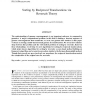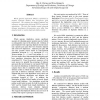192 search results - page 8 / 39 » Genome rearrangements with duplications |
JCB
2007
14 years 11 months ago
2007
The understanding of genome rearrangements is an important endeavor in comparative genomics. A major computational problem in this field is finding a shortest sequence of genome...
CSB
2005
IEEE
15 years 5 months ago
2005
IEEE
Whole genome duplication (WGD) is followed by massive duplicate deletion that reorganizes gene adjacencies. We compare the deletion patterns and adjacency reorganization following...
RECOMB
2008
Springer
16 years 4 days ago
2008
Springer
In the past years, many combinatorial arguments have been made to support the theory that mammalian genome rearrangement scenarios rely heavily on breakpoint reuse. Different model...
TCS
2008
14 years 11 months ago
2008
Genomes are dynamic molecules that are constantly undergoing mutations and rearrangements. The latter are large scale changes in a genome organisation that participate in the evol...
TCS
2008
14 years 11 months ago
2008
Most genome rearrangements (e.g., reversals and translocations) can be represented as 2-breaks that break a genome at 2 points and glue the resulting fragments in a new order. Mul...


